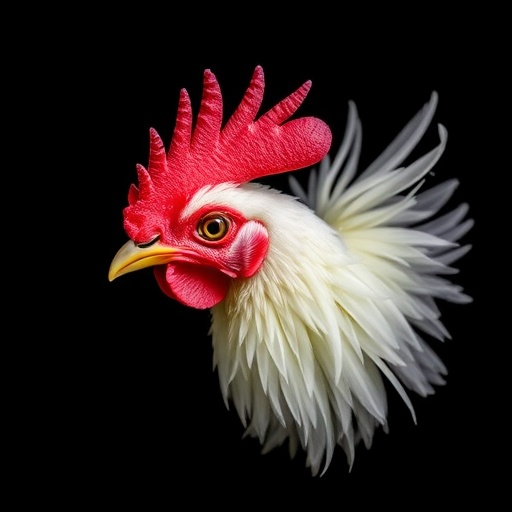Researchers have made significant strides in the field of waste management and sustainable agriculture by focusing on the bioconversion of chicken feather waste. This practice holds the potential to solve multiple environmental challenges, particularly in a world increasingly burdened by waste accumulation. By harnessing the power of specific microorganisms, two strains, Pseudomonas aeruginosa PA1045 and Alcaligenes faecalis IHB B 6507, have been identified to optimize keratinase production, an enzyme that can break down keratin, the primary protein found in chicken feathers. This revolutionary approach heralds a new era in both waste management and organic fertilization techniques.
Keratinase enzymes are pivotal in the degradation of keratinous materials, such as poultry feathers, which are often disposed of improperly, contributing to environmental pollution. The innovative research conducted by Otuyelu et al. not only focuses on optimizing the production of these enzymes through microbial action but also examines their efficacy when applied as organic fertilizers. The study encompasses a comprehensive analysis, detailing the enzymatic pathways exploited by the microorganisms to enhance keratin degradation efficiently.
The methodology involved in this research is meticulously designed, incorporating various experimental setups that assessed the conditions conducive for optimal keratinase production. By manipulating factors such as temperature, pH, and substrate concentration, the researchers were able to identify the most favorable conditions for microbial growth and enzyme production. This rigorous scientific approach highlights the precision needed in biotechnological applications, ensuring the methodologies stand robust against practical scrutiny.
As the experiments progressed, findings revealed that Pseudomonas aeruginosa PA1045 outperformed its counterpart, demonstrating higher keratinase activity at specific optimized conditions. This differentiation underscores the importance of microbial selection in biotechnological applications, as not all microorganisms exhibit the same capabilities for bioconversion processes. Further investigations into the molecular basis for these differences are necessary to unlock even greater potential in enzyme production and application.
The researchers also conducted a comprehensive characterization of the keratinase enzymes produced by these strains. This characterization included an analysis of their biochemical properties, stability at varying temperatures and pH levels, and their efficacy in feather degradation. Such detailed investigations are critical, as they inform the practical applications of these enzymes in agricultural settings, particularly in enhancing soil quality and crop productivity.
The organic fertilizers produced from the bioconversion of chicken feathers exhibit numerous advantages. By improving soil structure and nutrient content, they not only promote plant growth but also enhance microbial activity within the soil. This synergistic relationship is key to building sustainable agricultural practices that reduce reliance on synthetic fertilizers, which often have detrimental environmental impacts. The implications of this research extend beyond simple waste reduction, presenting a holistic solution for sustainable farming.
The ecological benefits of using processed chicken feather waste as organic fertilizer are manifold. In addition to reducing the volume of waste headed to landfills, the bioconversion process helps to minimize greenhouse gas emissions associated with waste decomposition. Additionally, the application of these organic fertilizers can improve the biodiversity of soil microbiota, fostering healthier ecosystems. The research team emphasizes this multifaceted advantage, advocating for the integration of such practices into mainstream agriculture.
Public health is also a concern as improper disposal of chicken feathers can attract pests and lead to unsanitary conditions. By recycling this waste into useful products, the researchers contribute to a cleaner environment and promote public health standards. This aspect of the research is increasingly relevant in light of global health crises that stem from inadequate waste management practices. The promotion of bioconversion methods can help communities achieve cleaner surroundings and bolster overall public safety.
In addressing potential economic benefits, this research presents a viable alternative for poultry farmers, who often struggle with the disposal of waste products. By shifting the perception of chicken feathers from waste to a valuable resource, farmers can improve their bottom line while simultaneously contributing to environmental sustainability. Moreover, the emerging trend towards organic farming markets further enhances the attractiveness of investing in such bioconversion technologies.
Proponents of sustainable agriculture can take cues from the insights offered by this research. By utilizing natural processes over synthetic interventions, the agricultural community can work towards a more sustainable and eco-friendly future. The efforts of Otuyelu et al. are not just academic; they pave the path for practical solutions that can be adopted at various scales, from small family farms to large agricultural enterprises.
Ultimately, the work showcased in this study lays foundational groundwork for ongoing research into microbial bioconversion processes. Future investigations may expand upon these findings, delving deeper into the genetic and environmental factors influencing enzyme production. The long-term goal should focus on optimizing these processes further, eventually leading to the commercial viability of chicken feather bioconversion at larger scales.
In conclusion, the bioconversion of chicken feather waste utilizing Pseudomonas aeruginosa PA1045 and Alcaligenes faecalis IHB B 6507 represents a pivotal advancement in the quest for sustainable agriculture. The optimization of keratinase production has profound implications not only for waste management but also for agricultural practices worldwide. As we move forward, embracing such innovative solutions will be essential in addressing pressing environmental challenges and fostering a healthier planet.
This transformative research offers hope and a framework for sustainable practices that can restore balance to an overburdened ecosystem. The commitment and technical achievements of Otuyelu et al. signify an exciting new chapter in the exploration of biotechnological solutions that harmonize with nature, ultimately benefitting all stakeholders involved in the agricultural supply chain.
Subject of Research: Bioconversion of chicken feather waste and keratinase production optimization
Article Title: Bioconversion of chicken feather waste: optimizing keratinase production by Pseudomonas aeruginosa PA1045 and Alcaligenes faecalis IHB B 6507, characterization and application as organic fertilizers.
Article References:
Otuyelu, F.O., Omojasola, P.F., Adebisi, O.O. et al. Bioconversion of chicken feather waste: optimizing keratinase production by Pseudomonas aeruginosa PA1045 and Alcaligenes faecalis IHB B 6507, characterization and application as organic fertilizers. Int Microbiol (2025). https://doi.org/10.1007/s10123-025-00750-8
Image Credits: AI Generated
DOI:
Keywords: Waste management, bioconversion, keratinase, sustainable agriculture, organic fertilizers, Pseudomonas aeruginosa, Alcaligenes faecalis, environmental benefits.




